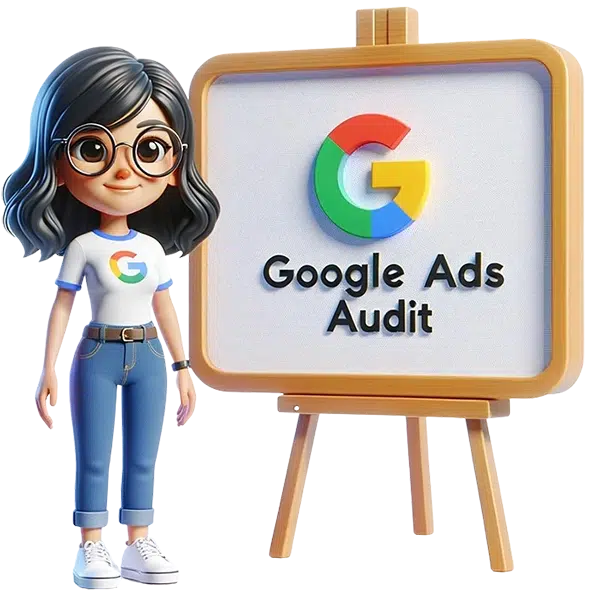
The Best Ways To Improve Your Google Ads ROI
Get a Live screen share review or a Written report.
- Expert audit review providing both a detailed and summary breakdown of your Google Ads account.
- Learn what are the areas with the most potential to increase leads and sales.
- Identify any areas already set up well.
- See which features are not set up covering the relevant capabilities of the Google Ads system.
- Recommendations backed up using your account data where ever possible.
Data Report
As part of the audit, we create a live report of your Google Ads account with an interactive calendar. The data is pulled from Google Ads automatically during each day.
Written Report
As part of the audit, we create a written or live screen share audit of your Google Ads account. We use screenshots or videos to run through the areas in each audit format.
Goals & Objectives
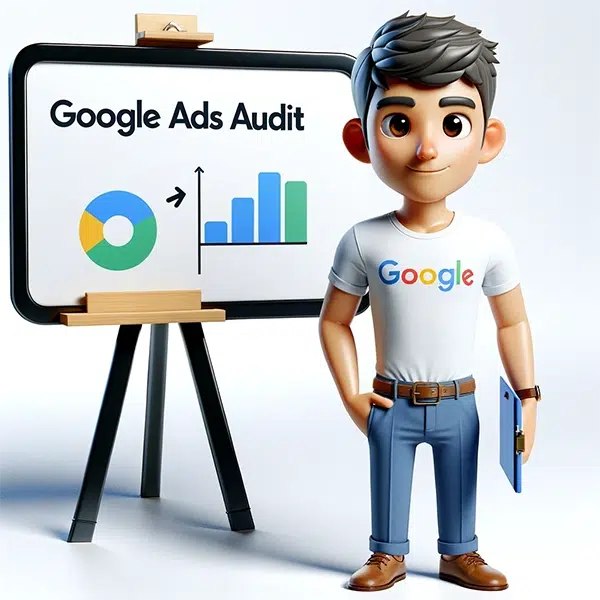
The audit includes a live screen share, a written report, and a live report of your Google Ads.
a) Advanced Report – Account summary & detailed report of your Google Ads account using Google Data Studio. This report shows performance metrics and dimensions in a visual, easy-to-understand format. This report updates automatically from Google each day to show current data.
b) Live Screen Share Audit review: We complete the account review and then schedule a time to explain our recommendations via a screen share. On this screen share, we delve into each area of your account with specific recommendations using your data.
c) Written Audit – Best practices along with specific recommendations to improve your Google Ads account. Each area of recommendations includes explanatory text that defines each area before discussing your precise business context. We also provide relevant links in each section to more detail of each area as a blog post.
d) Q&A: We finish by covering any questions you may have with the audit review.
Conversion Tracking shows you what happens after someone clicks on your ads – whether they purchased your product, filled in a form to become a lead or signed up for your newsletter
By tracking these actions, known as “conversions”, you’ll know which ads, keywords and campaigns work the most effectively. This helps invest more wisely and boost your return on investment(ROI) by getting more leads and sales.
Measure campaigns advertising performance with your website goals and your business offering.
Companies that optimise for leads are service providers, usually to get the most leads at the lowest cost per lead.
Optimisation for lead quality is also important to focus more spend on prospects more likely to become customers.
- Are the campaigns set up to optimise for leads with a target CPA?
- Do similar campaign types have similar CPA’s (cost per lead?
Companies that focus on e-commerce sell products or packaged services online.
- How does performance compare between Shopping Ads and Standard Text Ads?
- Are the campaigns optimised for ROAS and conversion value to maximize sales volume and profit?
This audit review includes both strengths and weaknesses of the current Google Ads setup. We review strategy and tactics based on your target market, industry and budget.
The review will roadmap quick wins, as well as medium-term improvements for getting a better ROI.
- Summary list of quick wins, and also a roadmap for medium-term wins.
- Highlight all the relevant techniques and features not yet used.
- The audit is comprehensive, but we do follow an 80/20 principle by working from the top-down focusing on the areas that can increase conversions and save you money.
Account Structure & Settings

Effective account organisation makes it easier to build, report, measure and improve your advertising efforts. Organised accounts make it easier to understand how well each area is performing – and then carry out the necessary adjustments for improvement.
Advanced optimisation such as bid management, ad testing and campaign experiments are easier to implement with a well-structured account.
An effective naming convention improves the manageability of a Google Ads account.
- Assess and score naming conventions applied to account assets such as campaigns, ad groups, ads, audiences, negative keyword lists and more.
- Check if Naming conventions should specify the targeting used such as keywords, audiences, placements, combination targets etc.
Automated rules save time and efficiency by making optimisation changes by event or time.
Automated rules are great for performing repetitive like changing bids, budgets and showing certain ads on times of the day.
Keyword bidding rules can also use cost per acquisition thresholds and performance targets for making adjustments. For complex rules, automation scripts provide more functionality.
Automation scripts take the principle of automated rules further with more complex options available. There are over 100 established scripts within the public domain and we develop and maintain our own scripts.
A well organised account with clear naming conversion improves the reporting of account performance at all levels.
Google has many of its own ad networks to show ads on, and the advertising platform also works with third-party websites and apps such as Google Search vs Google Search Partners. YouTube, Gmail and Google Play vs millions of websites and apps part of the Google Display Network.
- Summarize the networks and channels used, then make a performance comparison.
- Identify any quick wins across search, search partners and display.
Having too little or too many ad groups makes an account harder to optmise and manage.
Here we assess and score how well keywords (and the other targeting) are organised.
- Are there enough ad groups?
- Are the ad groups themed or following one keyword per ad group strategy?
- How are products groups organised within ad groups? (for e-commerce).
- Are display audiences separated into single ad groups and by audience types?
Performance by a device can vary such as desktop, mobile, tablets, TV and even smartwatches! Just like you should make your website responsive, your Google Ads account should be optimised by the device to achieve a better ROI
Ad serving issues occur when more than one keyword shows for the same search term. This causes self-competition which has adverse effects similar to duplicate keywords.
- Is the account well-organised account to help ensure correct keyword gets triggered by the closest search term- and therefore ad and landing page.
- Do negative keywords need to be applied at the ad group level to sculp traffic?
- Run keyword diagnostics and assess if granular traffic sculpting negatives should also be applied.
Campaign Settings

Report on geographic performance variation by distance, town, city or postcode. Assess opportunities for bidding, ad copy and landing page optimisation.
Google lets you target by the device language of a users website browser. This can be particularly effective when a target audience must be of a certain language.
Bid strategies are designed to optimise Google Ads to meet specific objectives.
- Does the bid strategy for each campaign match your goals?
- Are you looking to grow brand awareness, increase consideration or improve the conversion rate?
- Is manual or automatic bidding used?
- Automatic Bidding by CPA or ROAS can be very effective for getting the most sales or leads at your desired cost per acquisition.
Bidding for the top position, therefore, can be more effective for increased volume and brand awareness. These strategies can be mixed and matched across campaigns depending on metrics like conversion rate.
Website behaviour and marketing results vary by device, sometimes significantly.
- Which devices are being targeted, such as mobile, desktop and tablet and TV.
- What is the relative performance by device?
- Evaluate device strategy in comparison to advertising objectives and outline changes.
Automated rules save time and improve efficiency by making changes by time or other events to achieve your goals.
Automated rules are great for performing repetitive tasks like changing bids, budgets and showing certain ads.
Keyword bidding rules can also use cost per acquisition thresholds and performance targets for making adjustments. For complex rules, automation scripts provide more functionality.
Search volume, profitability and conversion rate may vary at different times of the day.
- Is it worth running ads 24/7 or only during business hours?
- Are their different bids for different days or time of the day
- Does the time of the day segments or days of the week vary by performance,?
For the purpose of split testing, it is possible to manually or automatically rotate (serve) ads based on specific advertising goals.
Manual optimisation is rotating the ads equally showing all ads the same amount of times.
Automatic optimisation allows Google to adjust ad serving based on performance metrics such as CTR or conversions.
Budgets can be set daily or by month for each campaign within Google Ads.
- Is there a clear goal for each campaign such as CPA, ROAS or awareness to measure performance and budget allocation?
- Assess and score how well spend is allocated by objective and performance targeting used.
- Are any campaigns exceeding their daily budgets, and would it be beneficial to increase the budget or decrease bids?
Campaign Types & Targeting
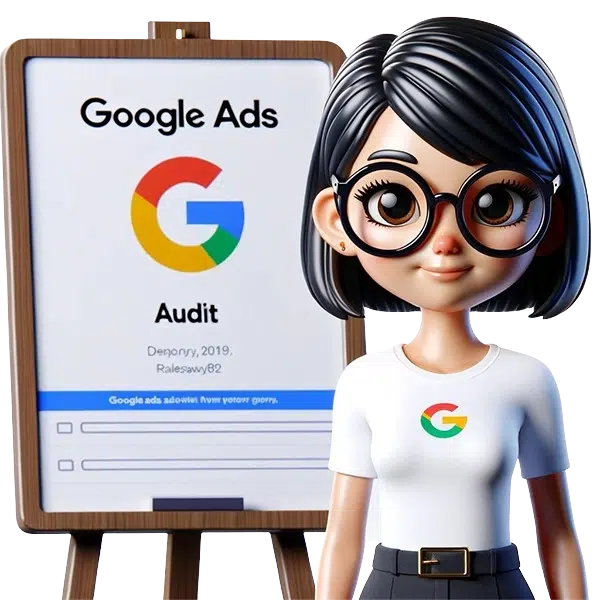
Keywords are the most widely used targeting options for Google Search.
- Average keywords per ad group,
- match types used and performance by type.
Top 1-5% of keywords by spend and conversions. Identify anomalies in CPA & conversion rate for keywords. - Check negative keywords, the number of negative lists and what levels are applied.
- Added vs not added ratio from search terms report.
Keywords are words or phrases used for targeting your ads with user search terms. The three most popular search types include:
Transactional Searches – People are looking to complete an action. Well suited for advertisers targeting prospects later in the buying cycle. Transactional keywords with commercial intent can be even more successful.
Informational Searches–Also known as “question words” as they frequently contain: “why,” “how,” and so on. Typically more useful for generating awareness and interest earlier in the buying cycle.
Navigational – people are searching for a website, company or brand name. Bid on your keywords to increase CTR and reinforce your brand by showing in the top ad position.
Quality Score is an estimate of how relevant your keywords, ads and website landing page are to a person seeing your ad. Higher quality scores typically lead to lower costs and more traffic.
Quality Score can be increased by improving expected CTR, landing page relevance, keyword/ad relevance, geographic performance and device performance.
Chart of quality score for all keywords with impressions
Bonus bonus: Find your QS weighted by
Impressions.
Google has a range of keyword match types including the exact, phrase, modified broad match and the default broad match type.
- What match types are used?
- Can any more be used?
Audience targeting for Google Search helps you get more granular in your targeting, and bid differently by demographics, past website user, similar audiences and in-market.
These are the actual searches entered into Google by people who click on your ads.
Identify relevant search terms with high potential to expand your keyword list with separate bids.
Search terms of less relevance to your business can be made negative keywords, increase CTR and reduce wasted spend. Optimum keyword match type combinations can be identified from the search terms report
Impression share is the number of times your ad was shown compared to the number of times it could be shown. Bidding higher will increase your impression share but will also increase the average cost per click.
- What’s the potential of this account? Is it constrained by Budget or Rank?
- Which campaigns can increase bids to get more impressions while still achieving the campaign primary goal.
- What is Top vs Other
Adverts & Destination Pages
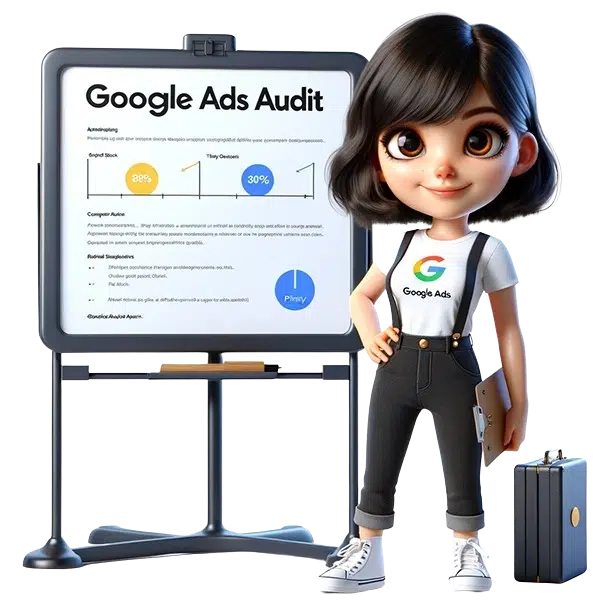
Every company has a business offer covering what you do, how you do it and why you do it. The business offer consists of unique selling points, features, benefits, guarantees, promotions, calls to action, proof testimonials and qualifications.
Even if your competitors are very similar, ad testing results show what parts of your business offer, sales copy and image assets appeal to your prospects and customers.
Key performance indicators (KPI) such as click-through rate, conversion rate and conversions per impression highlight ways to measure the performance of adverts.
A/B test results show the best ad versions while multivariate test results display the performance of ad elements like headlines, descriptions and even wording and phrasing.
Understanding the costs and conversions for each element of your advertising assets is critical for making sure the most useful parts of your offer get emphasized.
CTR is the number of clicks that your ad receives divided by the number of times your ad is shown: clicks ÷ impressions = CTR
Increasing CTR can increase traffic and conversions. Increasing your CTR can also increase the keyword quality score and therefore reduce advertising fees such as cost per click.
Google Ads have a range of advert formats across Search, Display and YouTube networks.
Google Search has Standard Text Ads, Responsive Ads for Search, Dynamic Search Ads, Shopping Ads.
Google Display has Responsive Ads and uploaded ads. Video Ads can run on YouTube and other video sites on the Display Network.
- Are ad types and formats being tested?
- Is their significant variation in performance?
Landing pages are important for both quality score and conversion rate. Google uses automated systems and human evaluation to determine landing page relevance. Improvements such as increased time on site can lead to higher quality scores over time.
Landing pages should be relevant to the advert copy by providing more detail about your business offering: features, benefits, guarantees, unique selling points, promotions, service, product, calls to action, locations and proof of services such as qualifications or reviews.
You can choose to send traffic from your ads to destinations such as your website home page, landing page, funnel or Mobile App.
- Is the homepage being used too much?
- Are their dedicated landing pages or sales funnels?
- What percentage of PPC traffic goes to the home page and what is the comparative conversion rate?
- Are A/B test ads and landing pages being tested consecutively to improve quality score and conversion rate?
Define ad testing strategy and outline ad testing approach and results.
- How many ads are there per group?
- Are big differences being tested, such as promotions, benefits, USP’s, guarantee?
Ad Extensions show below the base advert and can help increase CTR and conversion rate. There are various types of ad extensions including site links, callouts, locations, etc.
- Do all campaigns have the relevant ad extensions?
- Are any ad extensions suitable to be applied as account-level to streamline your efforts?
Google Display Network Audit
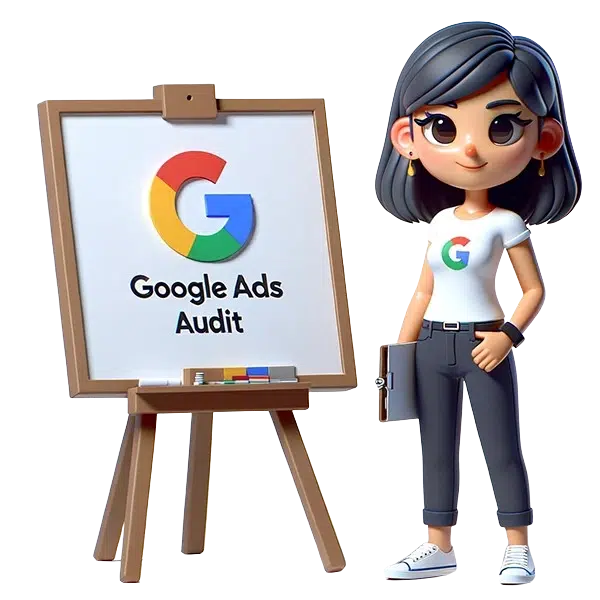
Audience targeting is the ability to show ads to groups of people on millions of websites and apps across the internet based on their shared interests, characteristics and content they interact with.
Target people that have never been to your website and retarget past website visitors for up to 540 days.
Broad audiences such as Demographics and Affinity are more suited for brand awareness top of funnel marketing. Layered audiences work better for consideration and conversion goals.
Google Display has a range of audience targeting options to reach prospective customers at all stages of their purchase funnel.
In-Market, Affinity and Custom Audiences, as well as Placements, Topics, Demographics, Remarketing and Similar audiences. These targeting options are available on the Google Display Network as well as YouTube and Gmail Ads.
- Are there placements that should be excluded, either websites or apps? (e.g. AdsenseForMobileApps.com)
- What are the metrics of Display compared to Search? For example cost per conversion.
- How qualified are the audiences?
- What potential impact on brand for display campaigns performing with a comparable CPA to Search?
- Are responsive or uploaded Ads used?
- Are dynamic ads or standard/static ads used?
- Are lots of versions being tested? More ads can be tested at the same time on the display network in comparison to the Search Network
- How are text ads performing compared to image ads?
Cold, warm and hot traffic are at different stages of their buying funnel.
- Does the ad copy match the audience being targeted? Does your ad copy stage of your prospective buyers purchase funnel?
- What’s the performance of Display compared to Search?
- How many targeting channels are used
- What’s the goal of these campaigns?
- How have the campaigns been organised?
- Does ad copy match the stage of the audience purchase funnel covering cold, warn and hot traffic?
Showing your ads next to controversial topics such as war, violence and crime can have a negative effect on your brand through association, conscious or subconscious.
- Are certain categories blocked such as tragedy, death, grief or emergency?
- Certain categories can be blocked to only associate your brand with categories where your audience are more likely to to be impacted from your ads.
- Are YouTube campaigns being used?
- What’s the performance like relative to others? What’s the goal of these campaigns?
- Are YouTube remarketing lists being built?
4 Step Audit Process
1
Pre-Call
15 Minute phone call to understand your company in more detail and provide context to the audit
2
Complete Audit
You enable partner access to your Google Ads, and we review your account in-depth.
3
Screenshare Audit
We do a live screen share audit to highlight the main areas of improvement like reducing cost, increasing leads or sales.
4
Written Audit
We provide the final written audit, along with a formal proposal for managing your Google Ads.
Start FREE Audit Process Now!
Step One = 15-30-minute call to understand your business and provide more context before the screen share and written audits are completed.
Audit FAQ
While the audit is free, to be eligible includes:
1.) You are currently looking for a new agency to manage your Google Ads.
2.) Your company is based in the UK
3.) The advertising is for your own company, not a client.
It is easier to understand the written audit after completing the live screen share. We feel that from past audits, this is the most effective way to communicate the improvements.
Temporary read-only access to your Google Ads account and Google Analytics. We provide assistance to this upon booking the audit.
The next step is to signup for monthly management. This is of course 100% optional. Budgetary pricing for monthly management is provided on our services pages,